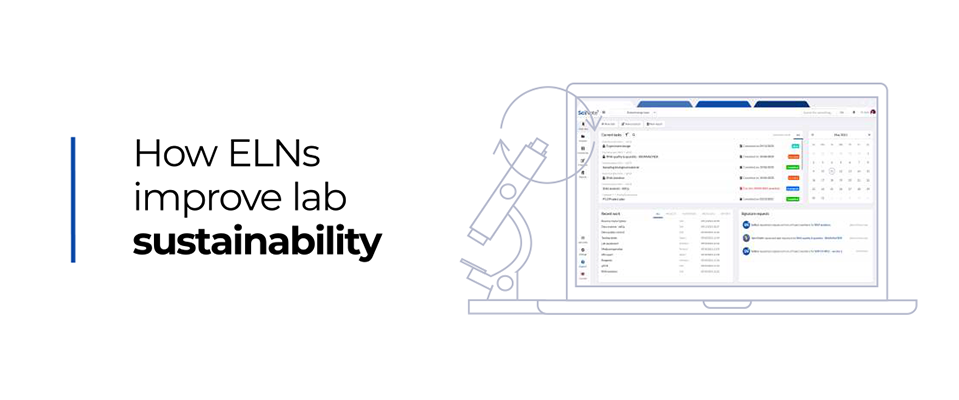How electronic lab notebooks (ELN) improve lab sustainability
“It is beneficial for pharmaceuticals and life sciences companies to take a step towards sustainability: firms that pursue a sustainable strategy and solidify their reputation as a sustainable company will gain the trust of governments, global institutions, and other stakeholders – partners on whom the long-term success of the industry depends.”
Dr. Robert Paffen, Partner, Risk Consulting Leader PwC Europe, PwC Deutschland
![]() 8 min read
8 min read
Content
Biotech sector: looking at the future without forgetting sustainability
The Life Sciences and Biotech sector has not considered sustainability as a particularly high priority in the past. This was partly due to the major challenges the sector faces in achieving a balance between resource usage and waste disposal. However, it is a fact that Life Sciences real estate uses up to 4 times the water and 10 times the energy of commercial office real estate. Data shows us that the global pharmaceutical industry is 55% more carbon emission intense than the automotive industry, and 4,4% of the worldwide global greenhouse gas emissions are produced by the healthcare sector (hospitals and laboratories) alone. Not only this. Scientists rely heavily on plastic in the day-to-day laboratory operations, and it is estimated that the Biotech sector uses enough plastic to cover 138,000 hectares each year.
It appears clear that sustainability solutions need to be considered to ensure that industries remain viable for both investors and occupiers.
Global sustainability trends in the Biotech sector
Deloitte reports that healthcare and life science organizations have already put in place mitigation strategies to reduce their carbon footprint and improve sustainability. For example, they prioritize suppliers that use sustainable materials in packaging and parts, have zero-carbon landfill policies, and recycle waste and water. Johnson & Johnson is investing $800m over the next 10 years to improve the health of people and the planet. By 2025, it expects to use 100% recyclable packaging and provide transparency for all its brands’ ingredients so that consumers can make an informed choice. Other initiatives include making disposable wipes from home-compostable, plant-based fibers. Kaiser Permanente, an American integrated managed care consortium, in 2020 made all its buildings energy-efficient, invested in sustainable business practices, and bought carbon offsets, becoming the first US health system to achieve carbon neutrality. And these are just some examples.
Why investing in lab sustainability helps your business
It is becoming more and more clear that investing in laboratory sustainability is a valid business decision with a clear return.
“It is beneficial for pharmaceuticals and life sciences companies to take a step towards sustainability: firms that pursue a sustainable strategy and solidify their reputation as a sustainable company will gain the trust of governments, global institutions, and other stakeholders – partners on whom the long-term success of the industry depends.”
Dr. Robert Paffen, Partner, Risk Consulting Leader PwC Europe, PwC Deutschland
In today’s research world, the amount of digital data that is being produced is increasing at a dramatic pace. It is estimated that more than 2.5 quintillion bytes of data are created every day and by 2025 there will be 175 zettabytes of data in the global datasphere. Because of this, the conventional lab notebook can no longer be considered the most efficient way to keep research records.
Especially in industry, researchers require a streamlined process and research documentation that is unified, and that incorporates the digital data obtained from their experiments. Importantly, an ELN solution for industrial research needs to provide the ability for scientists to comply with several regulations that guarantee that their research data can be found, accessed, and reproduced, now or in the future, without any constraints. Additionally, industrial researchers often need an ELN that complies with FDA, ISO & Good Laboratory Practice (GLP) regulations, including compliance to 21 CFR part 11 for the creation of digital records, and ensures that their intellectual property and data integrity are safely protected.
Biotech companies can develop electronic lab notebook templates and capabilities, adding in-house customizations to adapt the software to their business and then roll them out in different sites across the world. This allows them to meet their standards for harmonization and reproducibility and ensure overall enhanced efficiency of operations.
But how can lab sustainability be improved?
Learn more about SciNote ELN and how it can contribute to your work management.
Download SciNote functionalities overview PDF for free:
Ways to improve laboratory sustainability
Current laboratory sustainability efforts tend to focus on mitigating the amount of material and hazardous waste that gets discarded, reducing energy and water use, and incorporating green chemistry. Practical tips include turning off or unplugging the laboratory equipment or computers currently not being used, simplifying the waste management and recycling processes by clearly labeling bins with explanations about what type of waste belongs where or taking better care of the equipment with regular cleaning and maintenance aimed at increasing its lifespan. Another key area that offers an excellent opportunity for reducing the environmental impact of research is the introduction of an improved sharing of equipment into laboratory practices. Overall, introducing sustainability in the workplace culture can work wonders and really make a difference towards a greener science. In this context, electronic lab notebooks or ELNs can also be a great asset in the sustainability toolbox in the ever-changing biotech landscape. Let’s see how.
How electronic lab notebooks improve sustainability
- Increasing reproducibility – ELNs are so much more than the digital version of the paper lab book. They allow streamlining of processes and workflows, increasing reproducibility and avoiding unnecessary waste of resources repeating experiments. Often, experiments need to be reproduced and repeated also because it is hard to pinpoint hard copies of lab notebooks once someone leaves. ELNs bypass this issue too by automatically backing up data on a centralized system. In addition, ELNs allow a detailed reporting of processes, reagents, expected results, and avoidable issues, which all increase the reproducibility of scientific research, both internally and externally.
- Improving sample and inventory management – waste is a substantial contribution to the sustainability problem. When everything is archived in a nicely organized sample and inventory management system in an ELN, it is less likely that samples get lost, reagents expire, or are unnecessarily re-ordered, reducing the overall waste produced by a laboratory.
- Using less energy for storage space – this might not be intuitive at first, but if you think about it, conventional lab notebooks occupy quite a lot of physical space for cabinets and general storage. This is further accentuated by the requirements of many Universities/Departments or even journals to store everything related to a specific publication for many years. The use of ELNs leads to less laboratory space used for physical filing systems, which in turn leads to less energy used and improved sustainability of buildings.
- Encouraging and facilitating collaborations – Using ELNs encourages collaboration by providing collaborators all around the world with an easier, digitalized and paperless way to work on experiments and projects at every step. This is overall more sustainable because joint forces equal less waste. In addition, it also equals more focused experiments, once again avoiding the unnecessary waste of resources.
How to implement an ELN and why it’s easier than you think
Implementing an ELN in your research facility might be easier than you think. Having everything in one place, from protocol to pictures to excel sheets and analyzed data ready for publication, is intuitively much easier than having data scattered between paper lab books and different computers. Softwares have been optimized to be efficient, flexible, and user-friendly. For example, SciNote has different plans for different needs, and they are continuously being improved. You can check which one is the most suitable for you here and we can offer guidance in the sales process. You can also check concrete ideas and examples that can help you transfer your existing lab work to SciNote here. SciNote can be by your side through every step of the process, including the onboarding and implementation, as you can read in this published case study from the UK-based company Ingenza.
Once you’ve implemented an ELN and the staff is up to speed with it, the return of investment (ROI) is significant and goes well beyond the sustainability effort. On average, data shows that researchers save 9 hours per week by using an ELN, while doing the same amount of work. After the initial learning curve and investment into software, scientists can return their investment within 3 – 4 months.
If you want to know more about ELNs and how to transition to a digital lab notebook, contact us, and a SciNote specialist will be able to answer your questions.
You can also read all our testimonials from academia and industry, showing the time-saving and efficiency advantages of using an ELN.
By Dr Arianna Ferrini, biomedical scientist and medical writer





